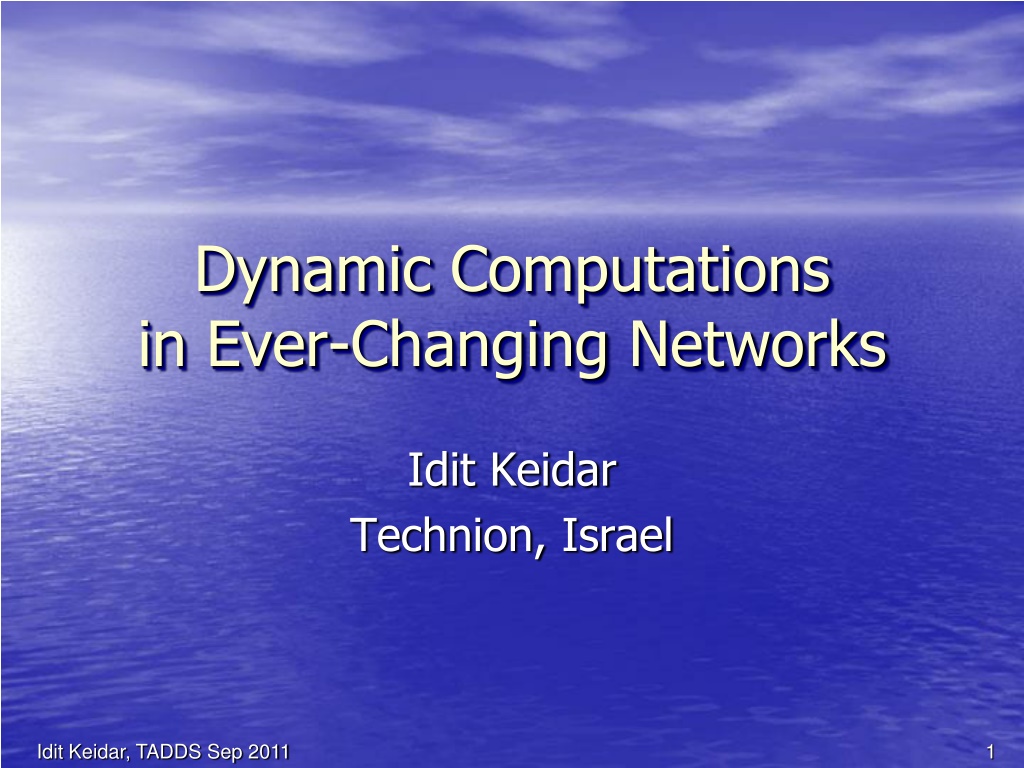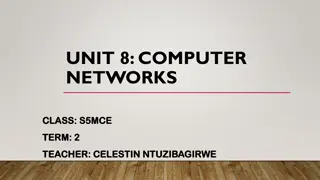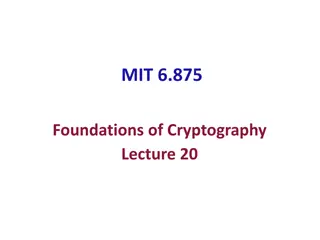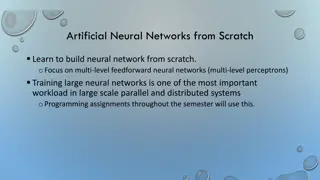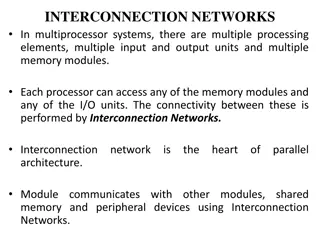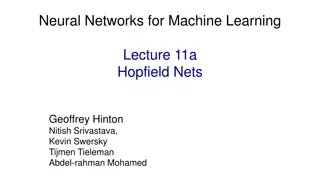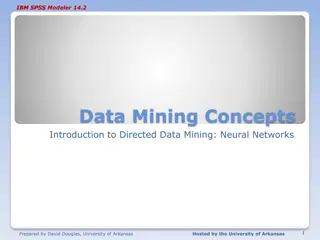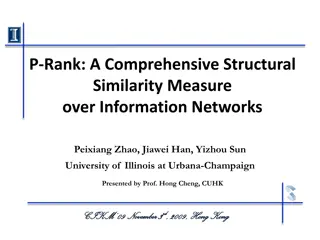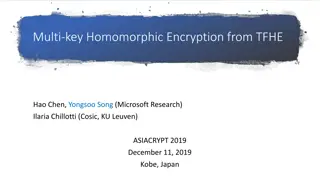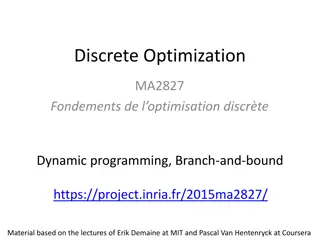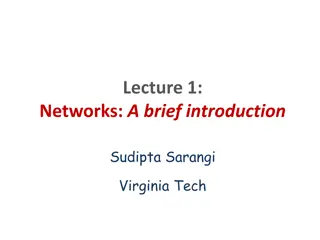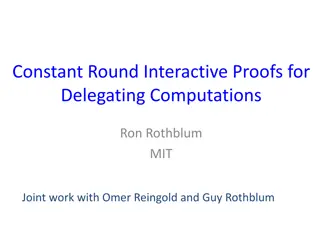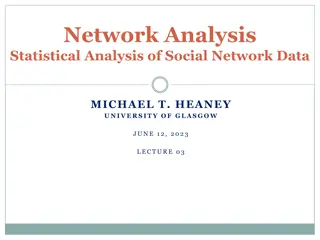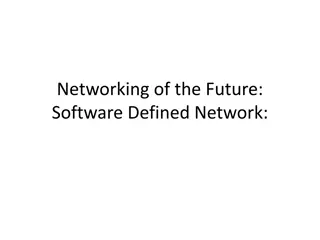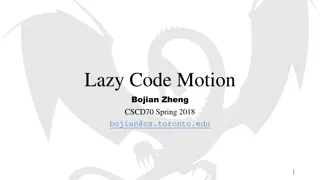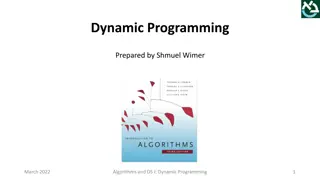Dynamic Computations in Ever-Changing Networks
Dynamic computations in ever-changing networks involve continuously adapting output to reflect input and environmental changes. This talk by Idit Keidar at TADDS Sep. 2011 explores the concept further, presenting examples like continuous weighted matching, live monitoring, and peer sampling. The discussion covers the challenges and dynamics of networks where computations are constantly interesting due to nodes and links changing, along with input variations such as sensor readings. Keidar delves into the specifics of dynamic continuous weighted matching in dynamic networks, emphasizing the motivation behind it and the evolving nature of network models.
Download Presentation

Please find below an Image/Link to download the presentation.
The content on the website is provided AS IS for your information and personal use only. It may not be sold, licensed, or shared on other websites without obtaining consent from the author.If you encounter any issues during the download, it is possible that the publisher has removed the file from their server.
You are allowed to download the files provided on this website for personal or commercial use, subject to the condition that they are used lawfully. All files are the property of their respective owners.
The content on the website is provided AS IS for your information and personal use only. It may not be sold, licensed, or shared on other websites without obtaining consent from the author.
E N D
Presentation Transcript
Dynamic Computations in Ever-Changing Networks Idit Keidar Technion, Israel Idit Keidar, TADDS Sep 2011 1
? TADDS: Theory of Dynamic Distributed Systems (This Workshop) Idit Keidar, TADDS Sep 2011 2
What I Mean By Dynamic* A dynamic computation Continuously adapts its output to reflect input and environment changes Other names Live, on-going, continuous, stabilizing *In this talk Idit Keidar, TADDS Sep 2011 3
In This Talk: Three Examples Continuous (dynamic) weighted matching Live monitoring (Dynamic) average aggregation) Peer sampling Aka gossip-based membership Idit Keidar, TADDS Sep 2011 4
Ever-Changing Networks* Where dynamic computations are interesting Network (nodes, links) constantly changes Computation inputs constantly change E.g., sensor reads Examples: Ad-hoc, vehicular nets mobility Sensor nets battery, weather Social nets people change friends, interests Clouds spanning multiple data-centers churn *My name for dynamic networks Idit Keidar, TADDS Sep 2011 5
Dynamic Continuous Weighted Matching in Dynamic Networks Ever-Changing With Liat Atsmon Guz, Gil Zussman Idit Keidar, TADDS Sep 2011 6
Weighted Matching Motivation: schedule transmissions in wireless network Links have weights, w:E Can represent message queue lengths, throughput, etc. Goal: maximize matching weight Mopt a matching with maximum weight 5 4 8 w(Mopt)=17 10 2 3 9 1 7 Idit Keidar, TADDS Sep 2011
Model Network is ever-changing, or dynamic Also called time-varying graph, dynamic communication network, evolving graph Et,Vt are time-varying sets, wt is a time- varying function Asynchronous communication No message loss unless links/node crash Perfect failure detection Idit Keidar, TADDS Sep 2011 8
Continuous Matching Problem 1. At any time t, every node v Vt outputs either or a neighbor u Vt as its match 2. If the network eventually stops changing, then eventually, every node v outputs u iff u outputs v Defining the matching at time t: A link e=(u,v) Mt, if both u and v output each other as their match at time t Note: matching defined pre-convergence Idit Keidar, TADDS Sep 2011 9
Classical Approach to Matching One-shot (static) algorithms Run periodically Each time over static input Bound convergence time Best known in asynchronous networks is O(|V|) Bound approximation ratio at the end Typically 2 Don t use the matching while algorithm is running Control phase Idit Keidar, TADDS Sep 2011 10
Self-Stabilizing Approach [Manne et al. 2008] Run all the time Adapt to changes But, even a small change can destabilize the entire matching for a long time Still same metrics: Convergence time from arbitrary state Approximation after convergence Idit Keidar, TADDS Sep 2011 11
Our Approach: Maximize Matching All the Time Run constantly Like self-stabilizing Do not wait for convergence It might never happen in a dynamic network! Strive for stability Keep current matching edges in the matching as much as possible Bound approximation throughout the run Local steps can take us back to the approximation quickly after a local change Idit Keidar, TADDS Sep 2011 12
Continuous Matching Strawman Asynchronous matching using Hoepman s (1-shot) Algorithm Always pick locally heaviest link for the matching Convergence in O(|V|) time from scratch Use same rule dynamically: if new locally heaviest link becomes available, grab it and drop conflicting links Idit Keidar, TADDS Sep 2011 13
Strawman Example 1 12 11 10 9 W(Mopt)=45 W(M)=20 11 10 9 8 7 Can take (|V|) time to converge to approximation! 12 11 10 9 11 10 9 8 7 W(M)=21 12 11 10 9 11 10 9 8 7 W(M)=22 2-approximation reached 12 11 10 9 11 10 9 8 7 W(M)=29 14 Idit Keidar, TADDS Sep 2011
Strawman Example 2 10 9 8 9 7 6 W(M)=24 10 9 8 9 7 6 W(M)=16 10 9 8 9 7 6 W(M)=17 Can decrease the matching weight! Idit Keidar, TADDS Sep 2011 15
DynaMatch Algorithm Idea Grab maximal augmenting links A link e is augmenting if adding e to M increases w(M) Augmentation weight w(e)-w(M adj(e)) > 0 A maximal augmenting link has maximum augmentation weight among adjacent links augmenting but NOT maximal 9 maximal augmenting 3 4 1 7 Idit Keidar, TADDS Sep 2011 16
Example 2 Revisited More stable after changes Monotonically increasing matching weight 10 9 8 9 7 6 Idit Keidar, TADDS Sep 2011 17
Example 1 Revisited Faster convergence to approximation 12 11 10 9 11 10 9 8 7 12 11 10 9 11 10 9 8 7 Idit Keidar, TADDS Sep 2011 18
General Result After a local change Link/node added, removed, weight change Convergence to approximation within constant number of steps Even before algorithm is quiescent (stable) Assuming it has stabilized before the change Idit Keidar, TADDS Sep 2011 19
Dynamic LiMoSense Live Monitoring in Dynamic Sensor Networks Ever-Changing With Ittay Eyal, Raphi Rom ALGOSENSORS'11 Idit Keidar, TADDS Sep 2011 20
The Problem 7 5 In sensor network Each sensor has a read value Average aggregation Compute average of read values Live monitoring Inputs constantly change Dynamically compute current average Motivation Environmental monitoring Cloud facility load monitoring 12 10 11 8 22 23 5 Idit Keidar, TADDS Sep 2011 21
Requirements Robustness Message loss Link failure/recovery battery decay, weather Node crash Limited bandwidth (battery), memory in nodes (motes) No centralized server Challenge: cannot collect the values Employ in-network aggregation Idit Keidar, TADDS Sep 2011 22
Previous Work: One-Shot Average Aggregation Assumes static input (sensor reads) Output at all nodes converges to average Gossip-based solution [Kempe et al.] Each node holds weighted estimate Sends part of its weight to a neighbor t 8,1.5 10,0.5 8.5, .. 8.5, .. 10,1 10,0.5 7,1 Invariant: read sum = weighted sum at all nodes and links Idit Keidar, TADDS Sep 2011 23
LiMoSense: Live Aggregation Adjust to read value changes Challenge: old read value may have spread to an unknown set of nodes Idea: update weighted estimate To fix the invariant Adjust the estimate: ( newRead i i i w 1 ) + prevRead est est i i Idit Keidar, TADDS Sep 2011 24
Adjusting The Estimate 1 w ( ) + newRead prevRead est est i i i i i Example: read value 0 1 Before 3,1 After 4,1 Case 1: 3,2 3.5,2 Case 2: Idit Keidar, TADDS Sep 2011 25
Robust Aggregation Challenges Message loss Breaks the invariant Solution idea: send summary of all previous values transmitted on the link Weight infinity Solution idea: hybrid push-pull solution, pull with negative weights Link/node failures Solution idea: undo sent messages Idit Keidar, TADDS Sep 2011 26
Correctness Results Theorem 1: The invariant always holds Theorem 2: After GST, all estimates converge to the average Convergence rate: exponential decay of mean square error Idit Keidar, TADDS Sep 2011 27
Simulation Example 100 nodes Input: standard normal distribution 10 nodes change Values +10 Idit Keidar, TADDS Sep 2011 28
Simulation Example 2 100 nodes Input: standard normal distribution Every 10 steps, 10 nodes change values +0.01 Idit Keidar, TADDS Sep 2011 29
Summary LiMoSense Live Average Monitoring Aggregate dynamic data reads Fault tolerant Message loss, link failure, node crash Correctness in dynamic asynchronous settings Exponential convergence after GST Quick reaction to dynamic behavior Idit Keidar, TADDS Sep 2011 30
Dynamic Correctness of Gossip-Based Membership under Message Loss With Maxim Gurevich PODC'09; SICOMP 2010 Idit Keidar, TADDS Sep 2011 31
The Setting Many nodes n 10,000s, 100,000s, 1,000,000s, Come and go Churn (=ever-changing input) Fully connected network topology Like the Internet Every joining node knows some others (Initial) Connectivity Idit Keidar, TADDS Sep 2011 32
Membership or Peer Sampling Each node needs to know some live nodes Has a view Set of node ids Supplied to the application Constantly refreshed (= dynamic output) Typical size log n Idit Keidar, TADDS Sep 2011 33
Applications Applications Gossip-based algorithm Unstructured overlay networks Gathering statistics Work best with random node samples Gossip algorithms converge fast Overlay networks are robust, good expanders Statistics are accurate Idit Keidar, TADDS Sep 2011 34
Modeling Membership Views Modeled as a directed graph w y v y w u v Idit Keidar, TADDS Sep 2011 35
Modeling Protocols: Graph Transformations View is used for maintenance Example: push protocol w z w v w w z u v Idit Keidar, TADDS Sep 2011 36
Desirable Properties? Randomness View should include random samples Holy grail for samples: IID Each sample uniformly distributed Each sample independent of other samples Avoid spatial dependencies among view entries Avoid correlations between nodes Good load balance among nodes Idit Keidar, TADDS Sep 2011 37
What About Churn? Views should constantly evolve Remove failed nodes, add joining ones Views should evolve to IID from any state Minimize temporal dependencies Dependence on the past should decay quickly Useful for application requiring fresh samples Idit Keidar, TADDS Sep 2011 38
Global Markov Chain A global state all n views in the system A protocol action transition between global states Global Markov Chain G u v u v Idit Keidar, TADDS Sep 2011 39
Defining Properties Formally Small views Bounded dout(u) Load balance Low variance of din(u) From any starting state, eventually (In the stationary distribution of MC on G) Uniformity Pr(v u.view) = Pr(w u.view) Spatial independence Pr(v u. view| y w. view) = Pr(v u. view) Perfect uniformity + spatial independence load balance Idit Keidar, TADDS Sep 2011 40
Temporal Independence Time to obtain views independent of the past From an expected state Refresh rate in the steady state Would have been much longer had we considered starting from arbitrary state O(n14) [Cooper09] Idit Keidar, TADDS Sep 2011 41
Existing Work: Practical Protocols Push protocol w w z z v v u u w Tolerates asynchrony, message loss Studied only empirically Good load balance [Lpbcast, Jelasity et al 07] Fast decay of temporal dependencies [Jelasity et al 07] Induce spatial dependence Idit Keidar, TADDS Sep 2011 42
Existing Work: Analysis w z Shuffle protocol * z w v z v w u v z w Analyzed theoretically [Allavena et al 05, Mahlmann et al 06] Uniformity, load balance, spatial independence Weak bounds (worst case) on temporal independence Unrealistic assumptions hard to implement Atomic actions with bi-directional communication No message loss Idit Keidar, TADDS Sep 2011 43
Our Contribution : Bridge This Gap A practical protocol Tolerates message loss, churn, failures No complex bookkeeping for atomic actions Formally prove the desirable properties Including under message loss Idit Keidar, TADDS Sep 2011 44
Send & Forget Membership The best of push and shuffle w Some view entries may be empty u w u v u w v w Perfect randomness without loss Idit Keidar, TADDS Sep 2011 45
S&F: Message Loss Message loss Or no empty entries in v s view w w u v u v Idit Keidar, TADDS Sep 2011 46
S&F: Compensating for Loss Edges (view entries) disappear due to loss Need to prevent views from emptying out Keep the sent ids when too few ids in view Push-like when views are too small But rare enough to limit dependencies w w u v u v Idit Keidar, TADDS Sep 2011 47
S&F: Advantages No bi-directional communication No complex bookkeeping Tolerates message loss Simple Without unrealistic assumptions Amenable to formal analysis Easy to implement Idit Keidar, TADDS Sep 2011 48
Key Contribution: Analysis Degree distribution (load balance) Stationary distribution of MC on global graph G Uniformity Spatial Independence Temporal Independence Hold even under (reasonable) message loss! Idit Keidar, TADDS Sep 2011 49
Conclusions Ever-changing networks are here to stay In these, need to solve dynamic versions of network problems We discussed three examples Matching Monitoring Peer sampling Many more have yet to be studied Idit Keidar, TADDS Sep 2011 50
